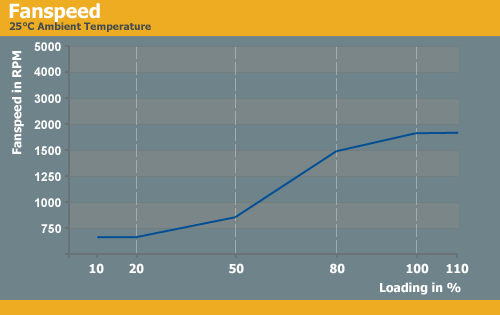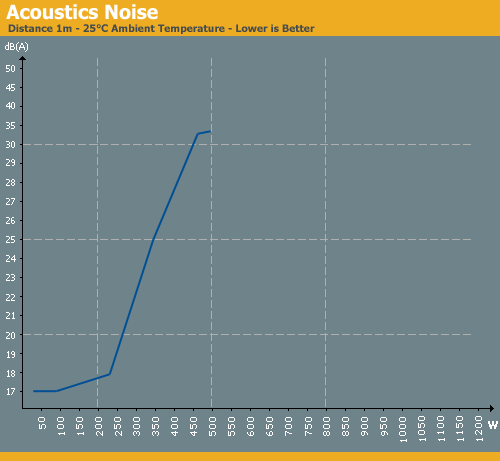Thermaltake TR2 QFan Series
by Christoph Katzer on November 19, 2008 3:00 AM EST- Posted in
- Cases/Cooling/PSUs
Temperatures, Fan Speed, and Acoustics

Both primary heatsinks hold stable at up to 40°C throughout testing, only surpassing that threshold when we overload the power supply. It's also nice to see that temperatures immediately decrease once the fan starts spinning faster. Of course we need to keep in mind that the heatsinks and fan don't need to deal with nearly as much heat, since these are only 300W to 450W PSUs. That's one of the benefits of using a smaller power supply.
We have previously commented that we didn't like the standard CWT heatsink design, with their "umbrella" fins blocking airflow and failing to dissipate heat as well as we would like. This time, due to less produced heat and a desire to cut costs, CWT used smaller heatsinks and the different temperature results are immediately visible. The only complaint we have is with the third heatsink; it should be larger, since even at room temperature it reaches up to 80°C.

The fan spins at a very tame 650RPM for the first couple loading stages. Once we reach 50% load, fan speed quickly begins to ramp up and is at 1500RPM with 80% load. The good news is that the heatsinks immediately get cooler, but the drawback is increased noise output. With a slightly better heatsink design and improved fan speed control, it should be possible to keep temperatures and noise levels down.

The acoustic noise develops fast with increasing fan speed. Going from 650RPM to 1500RPM brings a nice fat 10dB(A) increase in noise, which is not very good. The maximum noise output of 33dB(A) is unfortunately very loud. We strongly recommend that users interested in keeping noise levels down try to stay under 50% of the rated PSU output.










36 Comments
View All Comments
D3v - Monday, November 24, 2008 - link
It's nice to see a PSU review that clears up the fact that you don't need an 800-1000w PSU to run a Q6600 with a 4850 or a 9800. After I ran an 1900xtx512 setup with 'only' a 550W PSU (those cards eat power!), I just couldn't understand why anyone needed anything more.I hope they come out soon; they look fantastic, and are a step back to reality, for most of us.
Great review on a promising product. I didn't see the plus-80 stickers anywhere though.. did I miss something?
JohnMD1022 - Friday, November 21, 2008 - link
1. More reviews of 500w and under, of course.2. A push for more modular units at all levels.
3. A corresponding push for standardization of the plugs on the modular PSUs.
Number 3 is especially important... because...
If the connectors at the PSU end were standard, the cable manufacturers would make cables of varying lengths, colors, etc., just as they make USB cables, SATA, cables, etc.
It's so nice to buy 8, 10 and 12 inch SATA cables with 90 degree connectors.
Wouldn't it be great if we could get proper lengths for our PSU cables?
RagingDragon - Thursday, November 20, 2008 - link
Nice to see a review of small/moderate sized PSU's, and better yet to see you plan more of them in the future.The secondary heatsink temperature of these units look scary though, especially considering 80 degrees is very close to the 85 degree max heat rating of most inexpensive capacitors. I think I'll avoid these units for fear of exploding secondary capacitors... I'd like to see comparable results for the Seasonic 380W and 430W, the Corsair 450W and 550W units, and others in this power range - currently I'm using a Seasonic 430 and a Corsair 550, so I'd like to see how they perform relative to the competition.
Operandi - Thursday, November 20, 2008 - link
SamXon are actually very high quality caps, they rate right up and sometimes surpass the best from Japan. I wouldn't be worried about them failing.yehuda - Friday, November 21, 2008 - link
How do they compare with the secondary OST caps that Seasonic puts in its cheaper lines nowadays? I've seen them in the EarthWatt series, the CX400W [1] and the Seasonic branded OEM SS-400ET [2]. I wonder if the two Taiwanese companies are equally decent or if one has a better track record than the other.[1] http://www.pc-experience.de/wbb2/thread.php?thread...">http://www.pc-experience.de/wbb2/thread.php?thread...
[2] http://www.silentpcreview.com/forums/viewtopic.php...">http://www.silentpcreview.com/forums/viewtopic.php...
Operandi - Saturday, November 22, 2008 - link
SamXon specs out with some of the best. There was some long term testing done with also at badcaps.net and they passed that test as well with flying colors.As far as OST; I've seen them fail when placed in critical locations such as CPU VRM but they seem to fine in secondary locations and probably fine for PSU use. I know Seasonic uses (or used) them in their OEM units and they are still used in the lower wattage PCP&C Silencers which is OEM'd by Seasonic and I've never seen a failed Seasonic or PCP&C unit (I've personally used both).
yehuda - Sunday, November 23, 2008 - link
Thanks, I'll keep that in mind.Do you happen to have a link to the badcaps test? I occasionally visit their forum but I don't think I've come across it.
Operandi - Sunday, November 23, 2008 - link
The test is still going. Looks like it started in 2006, and all the caps are still holding their original ESR readings, except for the Samsung board that got killed by lighting. No surprise for the Rubycon and Panasonic but as you see the Samxon are right up there with them.I don't know how long they plan to run the test... if the Samxon are really as good as the Rubycon and Panasonics it could take awhile...
http://forums.badcaps.net/forum/showthread.php?t=2...">http://forums.badcaps.net/forum/showthread.php?t=2...
Kibbles - Wednesday, November 19, 2008 - link
I'm curious how these picoPSU fair.http://www.mini-box.com/picoPSU-120-power-kit?sc=8...">http://www.mini-box.com/picoPSU-120-power-kit?sc=8...
They seem to be just DC-DC converters but the 12v source is rated at 5amp. I don't see how they can call it a 120w kit. Still, this thing seems extremely enticing should you only need 100w for maybe a small HTPC.
They also have a 200w version on there, but the 12v source question comes into play again. If I'm calculating this right, for 200w at 100% eff, you would need 16.7amp from a 12v source.
JonnyDough - Thursday, November 20, 2008 - link
I second (third actually) the request for pico PSU reviews. We need a standard size PSU that can fit into iTX and mATX cases. I hope someone will create a standard size soon.